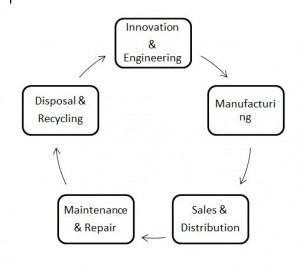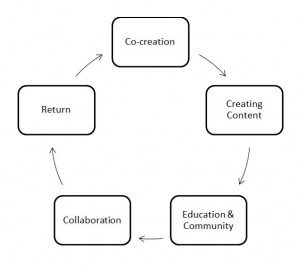The most difficult thing to do sometimes is to say I am done. How do you know when a product/service is finished? In Lean Thinking, we design (EDCA) for PDCA and only after we standardize do we consider the initial design finished. We are only finished when the product lifecyle is completed.
How are you at managing your Products Lifecycles? Are they being managed from Conception to Disposal or in a Green world, Recycled. I find this quite often an area that can develop rapid growth and additional streams of income very quickly. The organizations that are doing well in this economy are a result of taking a more outside in approach to the product lifecycle. Using a very simple Lifecycle diagram made up of five components, we can demonstrate this approach. 
What most companies are doing:
- Innovation & Engineering: Using new innovations tactic they are designing products with greater flexibility offer more product choices and flexibility later in the design process, Toyota Scion.
- Manufacturing: Lean processes have made tremendous advances in manufacturing the past several decades and has changed the way we view our own products. Learning to See Customer Value from the eyes of the customer has allowed for significant improvements in quality and customer satisfaction.
- Sale & Distribution: At the point of sale, customers now experience more choices, more flexibility and better pricing than they have ever had.
- Maintenance & Repair: Our expectations due to the advancement in quality accept little if any repair or maintenance during the entire lifecycle. We probably will throw it away before fixing it. However, when we do we will take it to a specialist versus doing it ourselves.
- Disposal & Recycling: We expect more of our items to be recyclable. Or is there is value left, saleable and that there is an easy distribution method for that to happen. A few examples are E-bay or Craigslist.
This is the normal lifecycle and expectations of most products and even services. So what makes you better? What differentiates you? It is a difficult chore to do it. It is even more difficult to get someone to notice it. And even more difficult to get someone to pay for it!!
What are the successful companies doing: Some companies make one of these areas a differentiator and target a customer segment that values that component. You can possibly charge more if that value proposition is strong enough for that segment or you can make it a minimal cost by burying it in the total cost of the service, such as a subscription rate. That price difference may seem minimal to that customer segment. Another way is to make one of these propositions an operational advantage that actually is saving you money. This is similar to the Theory of Constraints, Mafia offer. Companies are also partnering with others to create additional income streams and to maintain better customer “control”. For example, these companies may offer the ability to take and/or dispose of trade-ins. Or, additional service contracts, product attachments or aftermarket products may be possible.
What are the really successful companies doing: The really successful companies are not improving but looking at a totally different lifecycle. They realize that the value of product has diminished. There may even be little value place in the cost of ownership. The value is derived from the use of the product not in owning the product. So, they are looking at how to create value throughout the entire lifecycle.
The really successful companies are not improving but looking at a totally different lifecycle. They realize that the value of product has diminished. There may even be little value place in the cost of ownership. The value is derived from the use of the product not in owning the product. So, they are looking at how to create value throughout the entire lifecycle.
- Innovation & Engineering: Using Design Thinking Process, we focus on delivering to the customer Rapid Prototypes or Minimum Viable Products to garner their acceptance.
- Manufacturing: These processes are becoming practically secondary in nature. This is not where you make your money but where you continue your journey of development. No longer is software delivered in a box, it is in the cloud. You sell iPads, iPhones and iPods or even cars but the value is in what this enables the customer to do.
- Sale & Distribution: It is an entry point through a community and a joint-education process with the customer.
- Maintenance & Repair: Maintenance and repair is practically non-existent. This is where we maximize the value for the customer and extend his ability to do business better.
- Disposal & Recycling: Since there was little if any original value, there is little if any disposal or it is just a matter of returning it to you.
Think of what Amazon does.
- Innovation & Engineering: They have created Kindle and made a unique shopping experience that few match.
- Creating Content: They package, publish and inventory books.
- Educations and Community: Over 50% of the books sold on Amazon are electronic. This has now created a one-time fee for the Kindle, the cost of an eBook and instant delivery at the point of sale has made the purchase a minimal part of the experience. The price is relatively not an issue in most cases. It is just as often a decision based on the time you have. They educate you about product and though it may be a stretch since they have been around so long, were introduced through a community or eWOM.
- Maintenance & Repair: How often do you visit Amazon, just for a book purchase? They make a book purchase an adventure. You are updated, notified, asked for opinions, receive recommendations and watch your package travel to the destination. It is a journey with numerous touch-points that extend to your next purchase.
- Disposal & Recycling: Accept used book returns and allows you to loan certain books on Kindle.
As you develop your product lifecycle to an outside–in-approach it creates more touch points and more opportunities to interact with the customer. It also allows you greater opportunity to add value to your customer’s experience. That value will become an integral part of the way they do business. The strongest differentiator you can have.
Extra Material:
Don Reinertsen Books: Managing the Design Factory and The Principles of Product Development Flow: Second Generation Lean Product Development
Podcast: Creating Flow with Don Reinertsen (There is not an eBook)
